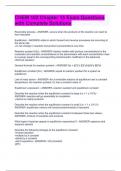Samenvatting
Gedrag in organisaties samenvatting, H6-9 H12-16, BDK 1
- Instelling
- Rijksuniversiteit Groningen (RuG)
Samenvatting van hoofdstuk 6-9 en hoofdstuk 12-16 van het boek Organisational behaviour (Sinding en Waldstrom, vijfde editie)
[Meer zien]














